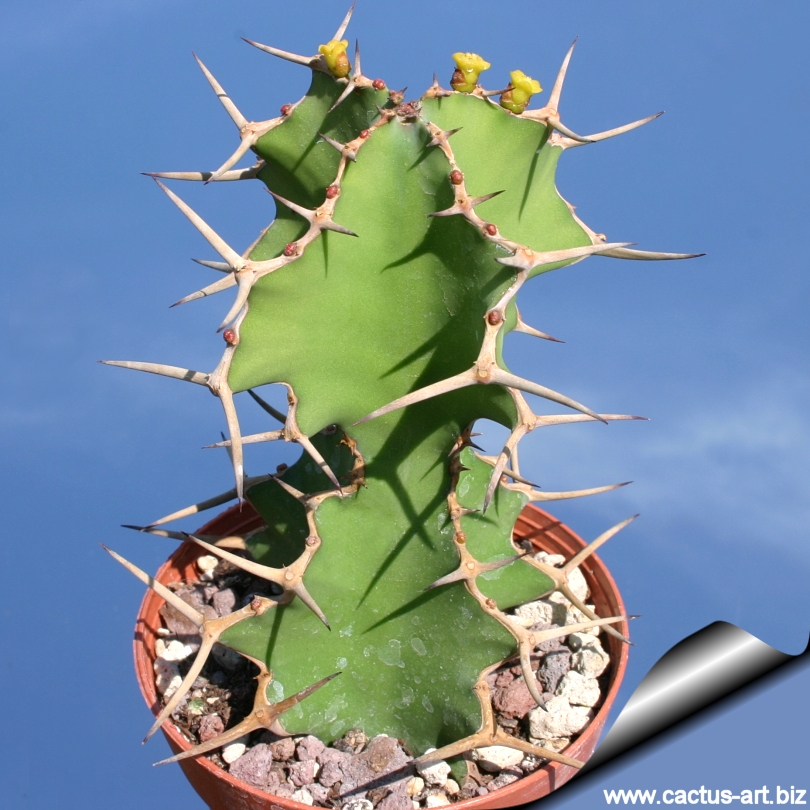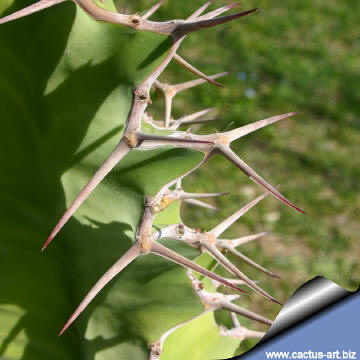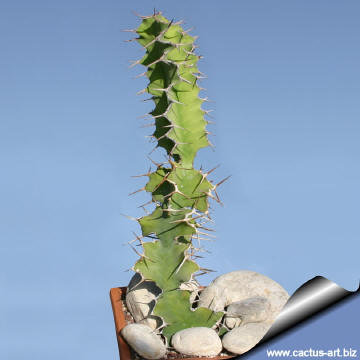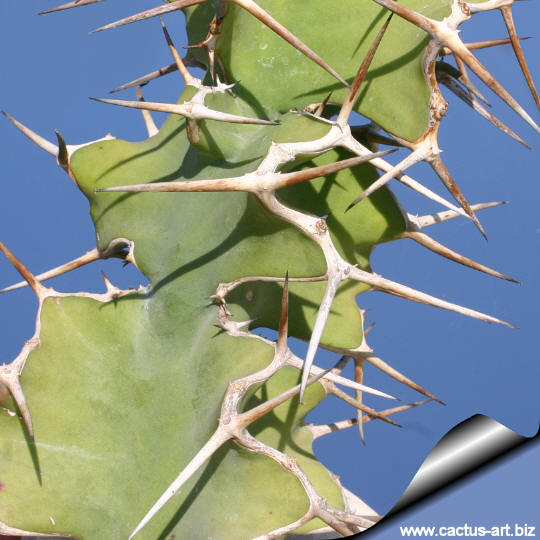|
|
|

Euphorbia
grandicornis
Superbly decorative cactus like Euphorbia with
strong impressive spines resembling the shape of cows’ horns. Placed
alone with its exaggerated form is as intriguing as a sculpture. It
bears tiny yellow to green flowers surrounded by little leaves.
|
|
Description: Great looking
upright multistemmed succulent shrub with strong spines resembling the
shape of cows’ horns. Has great angular and zig-zag shaped stems making
in a good ornamental choice. It has a close rigid bushy growth habit and
can become enormous, often collapsing under its own weight eventually
grows up to 2 m tall and about the same in width.
Stem: 3(-4) winged, up to 10 cm in diameter, irregular,
constricted in broad, twisted, triangular segments about 15 cm long.
Centre of the segments conspicuously pale.
Leaves: Tiny, scale-like between the spines, in summer where the
new growth forms, but usually devoid of leaves all winter. So that
photosyntesis is carried out by the green branches.
Spines: Spines shield grey or brownish, joined, forming a horny
continuous ridge, the (stipular) spines are paired 30-70 mm long.
Flowers: Quite striking and brilliant yellow cyathia, growing
just above the spines on the ridges of the terminal segment, usually on
mature plants, and mostly those growing in full sun. They are usually in
groups of three, the middle one (sessile) male and the other two (peduncled)
bisexual. Involucral bracts 8 m in diameter, glabrous, glands 5 up to 4
mm long entire yellow.
Blooming season: Flowers and fruits in late spring
Fruit: 3-lobed capsule, Ř 8 mm purple when ripe. They are quite
attractive lining up in rows on the angled ridges of the branches. |
 |
 |
|


Advertising
|
|
|
|
|
|
|
Family: Euphorbiaceae
Accepted
scientific name: Euphorbia
grandicornis Goebel exN.E.Br. subsp.
grandicornis
Common English Names include:
Cow's horn
euphorbia, Big horn, Rhino thorn, (They are also called Zig Zag Cactus).
Origin: KwaZulu-Natal, Swaziland, Mozambique, Kenya
Habitat: Grows in small colonies, on low
altitude on hot, dry, alluvial soil often with well-protected grass .
Conservation status: Listed in
CITES appendix 2.
|
|
|
|

Cultivation: It is an easy species to grow that is suited for any
well drained soil in full sun. But young plant are happy growing
indoors, where they can easily reach the ceiling. Give the plant an airy
growing medium which mainly consists of non organic material such us
clay, pumice, lava grit, and only a little peat or leaf-mould. Water
regularly during the active growing season from March to September. No
water should ever be allowed to stand around the roots. Keep almost
completely dry in winter. It is a moderately fast grower, and will
quickly become large landscape masterpieces in just 3-5 years. Only
downside is from strong winds, the columns often smash into each other,
causing permanent scarring... best to plant in such a location where
winds are not a big issue. If plant becomes very red, this is a sign
that the roots have not developed properly. It is a relatively fast
growing and long lived plant and once established, it will be content in
its position and with its soil for years. It can tolerate moderate
shade, and a plant that has been growing in shade should be slowly
hardened off before placing it in full sun as the plant will be severely
scorched if moved too suddenly from shade into sun. Like quite small
pots, repott in very later winter, early spring. Can be pruned for shape
and branching. Frost tender, frost free zones only. Plant Pests:
Prone to mealy bugs and rarely scale.
Propagation: It is
easy to propagate by cuttings in late spring to summer, just take
a cutting of the plant let it dry for 1 or 2 weeks and stuff it in the
ground (preferably dry, loose, extremely well draining soil).
Warning: All Euphorbias contain a white sap
that can be irritating to eyes and mucous membranes. If contact is made
with this white sap, take care to not touch face or eyes before washing
hands with soap and water.
Use: Makes a great barrier
plant. It can be pruned regularly and kept short or be allowed to grow
tall. If you have goats or cattle, they will eat this plant on the edges
, trying to avoid the spines. It seems the latex doesn't bother or
irritate the animals, truly weird!
|
|